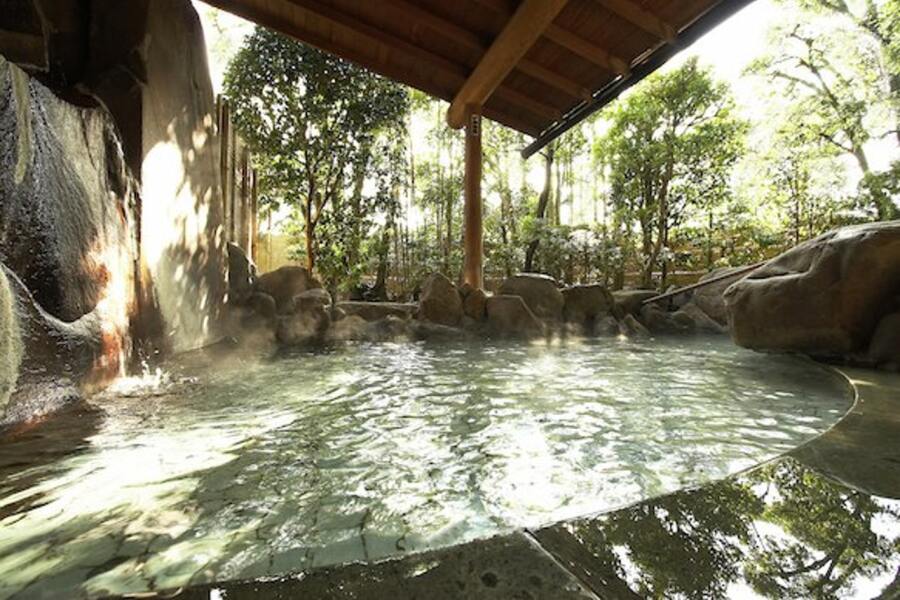The crisp cotton yukata robe rubs gently against my skin as I walk out of the ryokan, a traditional Japanese inn, into the brisk evening air. I cross a tiny bridge, a gentle wind tousling the peach trees and swaying the golden lanterns that light my way along the stone path. Forty-eight. That’s how many steps I count in my walking meditation down to the outdoor hot spring.
Soaking in an onsen, a communal hot spring bath, has been one of Japan’s favorite pastimes for decades, originating in an era when most families did not have their own bathing facilities. The custom has endured even as the country has prospered. Communal baths are common in cities (where the water may or may not come from a natural spring), but for the Japanese, escaping to an onsen allows them to reconnect with nature. “You can experience four seasons,” says Gen Tamura, a 30-year-old cook from Chiba who visits an onsen several times a year. “You observe the cherry blossoms, the ocean, the fall foliage, the snow, the moon.”
Zagyosoh, where I’m staying, is located in Izu National Park, two hours west of Tokyo. It’s an easy trip for city residents who come to stroll among the ryokan’s elaborate gardens and indigenous peach trees as well as bathe.
There are more than 55,000 ryokan in Japan, and about 15,000 have onsen. The typical experience plays out like this: bathe, eat, bathe, sleep, bathe, eat, bathe. When I arrived at 6 p.m., my caretaker, Ms. Ayano, told me in a slightly scolding tone that most customers arrive earlier in the afternoon to have their first bath. After showing me to my room, she recommended that I take my morning bath at 6:30 a.m. so I would be out when attendants came to put away the blankets at precisely 7:10 a.m.
All evening, ladies in kimonos shuffled in and out of my room—which had sections for sleeping, changing, and eating, each with perfectly rectangular rice straw–cushioned tatami mats on the floor—to attend to my needs. They set up and served a meal of 14 small courses, among them crab-and-egg custard, cream cheese and avocado mousse, and duck with rose jelly. The women returned immediately after I finished my last dish to clear and stash the table and to arrange my blankets. Then it was time for my first bath.
My 48-step trip takes me to a rotenburo (outdoor bath) nestled amid trees and large rocks. In the solitary wooden house that serves as a dressing room, I look out the window and see a small, steady waterfall dumping water aggressively into a steaming pool fed by the hot spring. I slip out of my robe. I wash my body off at the faucet, tie my hair in a bun, and tiptoe out toward the steam-covered rocks. The hot spring water is a smooth, liquid blanket of bliss.
After 15 minutes in the rotenburo, I migrate over to the daiyokujo, the main indoor bath building. I enter to the sight of three older women standing naked in the changing room, checking their cell phones, drying their hair, and pulling on their underwear. Inside the 1,500-square-foot bath hall, two middle-aged women chat by the window. All I hear, though, are the sounds of water: the fresh hot spring gushing into the bath; waves splashing as women wade through it; showers spraying bodies clean; a cold fountain trickling politely next to the entrance for quick cool-downs. I instinctively cover my breasts and private parts with a towel. And then I remember. In a Japanese onsen, being in close quarters with naked strangers is not weird at all. Going to a hot spring is about becoming part of nature. I drop my towel and my inhibitions, enter the bath, and indulge in the purity of it all.
Rogner Bad Blumau in Styria, Austria
Rogner Bad Blumau, 43/(0) 33-835-1000
Ecologically minded architect Friedensreich Hundertwasser designed this compound’s central spa, living roofs, and buildings topped by onion domes. A portion of your bill goes to the World Wildlife Fund.
Tabacón Grand Spa Thermal Resort in Alajuela, Costa Rica
Tabacón Grand Spa Thermal Resort, (877) 277-8291
A luxury hotel in the shadow of Arenal Volcano features a series of pools—one equipped with slides—and waterfalls set amid tropical gardens. Lava streaming from the volcano may provide an after-dark show.
Puyuhuapi Lodge and Spa, Patagonia, Chile
Puyuhuapi Lodge and Spa, 56/(0) 2-225-6489
A trip by air, land, and sea brings you to a remote resort on the shores of Dorita Bay in northern Patagonia. Visitors indulge in a full range of spa treatments and soak in pools fed by the ocean, Andean waterfalls, and natural hot springs.
Evason Ma’In in Jordan
Evason Ma’In, (800) 591-7480
Take in views of a hot spring–fed waterfall, a dramatic ravine, and the Dead Sea from a resort that sits more than 800 feet below sea level. A cliff-top outdoor restaurant serves organic greens from the garden.








